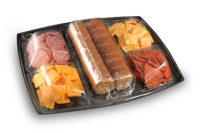New technologies, analyses make it easier to build an energy-efficient warehouse.
Editor's note: To learn more about cold storage insulation trends, Refrigerated & Frozen Foods contacted Herbert Slone, a technical manager for commercial insulation at Owens Corning, Toledo, Ohio. A registered architect, Slone recently spoke about insulation technologies at a meeting of the International Association for Cold Storage Construction (IACSC).
Refrigerated & Frozen Foods: As a supplier to the cold storage construction industry, you addressed IACSC's mid-summer conference last year. What does your company supply to the industry?
Herbert Slone: Owens Corning manufactures a complete line of Foamular Extruded Polystyrene Insulation (XPS) products for use in low-temp building construction. One of the key benefits of Foamular XPS products is compressive strength. Foamular is manufactured in multiple compressive strengths ranging from 15 psi to 100 psi. The variety of available strengths enables designers to select a high strength product suitable for use under high traffic and/or high load floor slabs supporting rack storage; intermediate strength product for use where compressive loads are much lower such as around foundations or in walls; or intermediate strength products for use on roofs where light foot traffic is expected for maintenance.
Additionally, Foamular XPS is well suited for use in low-temp building construction due to its water resistance, long-term stable R-value and its strength.
R&FF: The first part of your presentation addressed differences in insulation products. Can you briefly recap and describe the market - in terms of available products and their differences?
Slone: Foam plastic insulations are commonly referred to as "closed cell," which can have different meanings for specific insulation types.
Our Foamular XPS has a truly closed, well-defined cell structure that is composed from hydrophobic polystyrene polymer. That combination of characteristics makes Foamular XPS highly resistant to water absorption. For more detailed information on the specifications, see the material standard ASTM C578, "Standard Specification for Rigid, Cellular Polystyrene Thermal Insulation."
R&FF: What might be users' biggest misperceptions about insulation products?
Slone: A big misperception is that published properties for different types of insulation are directly comparable. Specifiers need to identify test methods used to measure properties and ask for differences to be identified if identical methods were not used to measure different products.
R&FF: How was the XPS insulation product developed? Can you recap its uses and benefits?
Slone: Foamular - and XPS in general - has a long track record of successful use in low-temp construction. A study published in November 1998 by the U.S. Army Corps of engineers Cold Regions Research and Engineering Laboratory (CRREL), concluded that, "...the only currently available roof insulation that can offer much improved moisture resistance in the roofs of coolers and freezers is extruded polystyrene."
The CRREL study removed insulation from 10 real low-temp building roofs and found that eight had significant moisture and ice build-up. There were many causes of wetting, including flaws in membranes and flashings, inadequate air seals at roof-wall intersections and, of course, the ever present sustained one-way vapor drive. Moisture resistance is a common concern for specifiers. The presence of moisture can degrade the R-Value of the insulation and support mold growth. Foamular XPS reduces building life-cycle energy cost and maintains a stable long-term insulating value even in the presence of moisture. Owens Corning provides a complete moisture control system of insulation and moisture management products, including Foamular, that work in concert to create a tight seal and maximize energy efficiency. Whether it is a retail building, a school or a freezer, absorbed moisture has to be avoided for sustainable and energy efficient construction.
R&FF: Your presentation mentioned applying a "life cycle cost analysis" to insulation. Please explain that concept.
Slone: Buildings are the No. 1 user of energy in America - at 40 percent. That's more than industry and more than transportation. Energy today is clearly a precious resource, which costs money and is increasing in cost daily.
The good news is that energy efficiency is the cheapest energy that anyone can buy. For every layer of insulation added, there is energy efficiency gained, while also improving the overall efficiency of building systems. This lowers the cost to heat and cool buildings, improves overall building comfort and reduces associated greenhouse gas emissions. To top it off, fiberglass and foam insulations are passive systems that consume no additional resources and maintain performance as they continue to save energy year after year.
Insulation should be evaluated like any other investment to maximize the overall return and lifecycle cost considering current and future energy costs. Life cycle cost analysis is one way to examine insulation as an investment.
R&FF: How can building operators best assess an optimum insulation level?
Slone: The economic optimum insulation level is the amount of insulation that has the ideal balance of acquiring energy efficiency with the lowest life cycle cost (LCC). LCC can be expressed as: LCC = FC+M+R+E-RV
LCC = Life Cycle Cost ($)
FC = First Cost ($)
M = Maintenance and repair cost ($)
R = Replacement cost ($)
E = Energy cost ($)
RV = Resale Value or salvage ($)
The concept of determining the lowest life cycle cost shows that if more insulation is installed, the first cost increases, but, in turn, the energy cost decreases. Although adding more insulation helps decrease energy consumption, at a certain point the rate of energy cost savings slows, which is why it is important to find the life cycle cost (LCC).
The lowest sum of first cost and energy cost will give the life cycle cost. In the hypothetical example of Figure 1, R-20 is the lowest LCC, and, is therefore the optimum insulation level. This example only demonstrates the concept of "optimum insulation." Actual optimum levels must be calculated for specific climates, building construction types, building usage patterns and economic assumptions.
Owens Corning has developed an optimum insulation calculator that our low-temp insulation sales representatives use with customers to estimate optimum insulation for floors, roofs and walls. Sometimes the calculator validates what building owners and contractors are already doing. Sometimes it provokes a good discussion about long-term economic assumptions, rising energy costs, growing global impacts and evolving insulating practices.
The International Association for Cold Storage Construction represents member companies as an industry. Based in Alexandria, Va., IACSC provides a forum for innovative ideas, promoting standards of practice for the cold storage construction industry, sponsoring professional education programs and promoting the interests of the industry in political, legal and regulatory arenas. For more information call (703) 373-4300 or visit www.iacsc.org.
LOGISTICS BRIEFS
Larry Larsen, chairman and CEO of Millard Refrigerated Services LLC, died at his Omaha, Neb., home on Sunday, March 9, 2008. Larsen, who was 69, founded Millard in 1962 with one 80,000-sq.-ft. warehouse, according to the company's Web site (www.millardref.com). Today, Millard is one of the nation's largest third-party warehouse operators with 35 locations and more than 300 million cu. ft. of storage.
The nation's largest third-party warehousing and logistics provider, Atlanta's AmeriCold Logistics, now has one owner - instead of three. Investors Vornado Realty Trust, Paramus, N.J., and Morgan Stanley Real Estate, New York, recently said they sold their shares in AmeriCold to The Yucaipa Cos. LLC, a Los Angeles holding company.
United States Cold Storage (USCS), Voorhees, N.J., said it opened a 5.2-million-cu.-ft. public refrigerated warehouse in Lake City, Fla., to serve major southeast metro markets, including Atlanta and Macon, Ga.; Birmingham and Mobile, Ala.; as well as the Florida cities of Tallahassee, Orlando and Jacksonville. Officials say the facility is designed for high-volume distribution with 18,000 variable-height racked pallet positions at temperatures ranging from -20ºF to +55ºF.
Execs on the Move: Nordic Cold Storage, Atlanta, said it hired Patrick Floyd as chief operating officer. Floyd formerly was senior executive vice president with SuperValu's Total Logistic Control business. ... SCS Refrigerated Services LLC, Algona, Wash., said it hired Carl Byrnes as vice president of business development.
Interstate Warehousing Inc., Fort Wayne, Ind., said it expects by this fall to complete a 135,000-sq.-ft. addition to its temperature-controlled warehouse in Franklin, Ind., just south of Indianapolis. Interstate said the Phase II expansion will house approximately 40,000 more pallet positions for chilled and/or frozen storage.
The Global Cold Chain Alliance - a group of four major supply chain associations - has published its 2008 Global Cold Chain Directory, a 500-page resource available free to food processors. The guide features six color-coded sections with listings for U.S. and international cold storage providers, refrigerated transportation companies, cold storage design experts and third-party support service companies. Visit www.gcca.org or call (703) 373-4300 for details.


